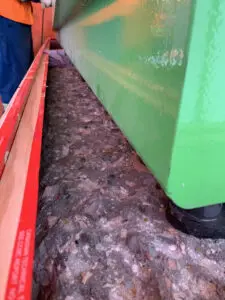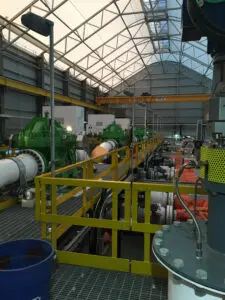
ALIGNMENT FROM THE GROUND UP
I recently had the opportunity to work with and discuss shaft alignments with some millwrights from a maintenance back round and made me reflect on some of the experience that has shaped my view of alignment. Often what I hear when working in the maintenance field is “good enough” and “it will run forever like that”. While this may be true at times it and have some relevance, it reflects some poor attitudes towards machinery alignment. Often the case in maintenance alignments is you do not have the time or resources to correct previous or on-going issues. The equipment often needs to be back in service in a short window or it may not be economical to correct things such as soft caused by bases or machinery not being perfectly flat or the foot is angled to the base. I have often observed that bases have a twist to them causing not only soft foot but shafts to form somewhat of an S curve.
All these issues can lead to several on going problems. The most common being loss of clearances in critical parts of the machinery. Symptoms of misalignments issues can be reduced life of the parts in the machinery such as bearings, seals and other moving parts. Even when the coupling of the machinery is in alignment these issues can be present and cause damaging vibrations within the equipment. Just like a solid house proper equipment alignment rely heavily on their foundations.
This is where the experience of proper construction can play an important role in understanding of equipment foundations and base installations. Pic Industrial has had the benefit of installing equipment from concrete up. We will commonly supply the base plates for motors as well as driven equipment a
nd have the benefits to achieve the highest results of flatness in these components. Knowing the importance of flatness in achieving the most stringent specifications of installation on the most critical equipment is key. Once we verify the flatness of the base plates, we are working with we can easily
achieve near perfect level in both co planer and co linear measurements. Knowing your base is level you can now proceed to verifying the flatness of the equipment which is often not easy to do and can require special blocking and jigs to measure the flatness of equipment feet. After grouting the equipment bases in using the highest of standards beyond manufactures specifications we can now proceed to rough alignments. Often what we will do at this stage is align the driver to the equipment having everything centered in its hold down bolts and precisely mark out for the hold down bolts of the driver and drill and tap the hold down bolts holes thus eliminating any risk of being bolt bound on our final alignments.
Piping is the next challenge in the installation process of the equipment. Painstaking efforts must be taken to have no to minimal strain on the equipment fro
m piping. Monitoring the equipment shafts during piping installations and having no more than 1 to 2 thousandths of movement in the equipment at the coupling is critical. Much like soft foot pipe strain will translate hidden stresses through the equipment and can damage equipment over time as
well as cause the equipment to move over time.

Now that we have walked through the process of installation from concrete preparation to pipe strain, we have only our final alignments before the equipment is ready to run. The steps will seem relatively simple when you walk slowly and methodically, however with simple steps comes simple rules. When you have simple rules to follow there is often no room for deviation from these rules. When each step in the process yields high results and precision you are left with a proper equipment alignment. It is often the case that the final alignment of equipment weighing several thousands of kilograms and rated for thousands of horsepower will take less than a few hours. When the foundation of the equipment is proper alignments look easy and there is absolutely no need to ever say that the alignment is good enough. The absolute highest standards of alignment are achievable when all the components of alignment come together. Having the background of seeing equipment installed and the final product is a great alignment helps to spot and recognize problems when aligning troublesome equipment. Some of the best millwrights I have worked with can recognize when things such as soft foot, twisted bases, pipe strain, bolt bound or out of flat bases are the source of the issues. When you have a complete picture of the alignment process and know the source for issues that arise during alignment you will be better able to mitigate and resolve the issues.
There will always be a large range of equipment with different degrees of tolerances and barriers to achieving the perfect alignment but the better you can understand the process of alignment the better your alignments will be. Knowing that alignments start from the ground up will leave you a better millwright and with a more ability to properly perform equipment alignments.
